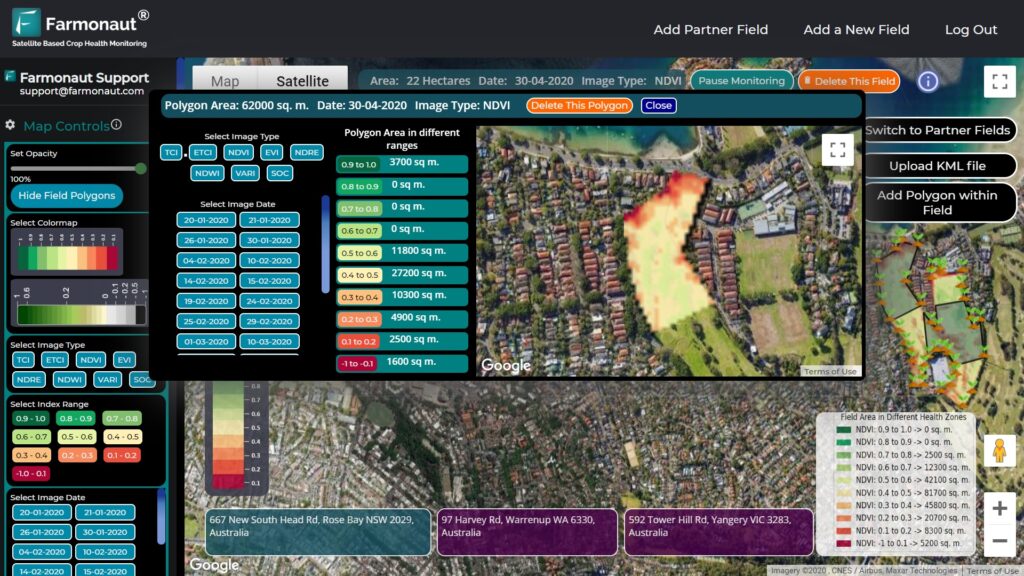Severe Winter Storm Alert: Southern California Braces for Heavy Rainfall, Flooding, and Mountain Snow
“Southern California’s upcoming storm could bring up to 4 inches of rain in 36 hours to foothill regions.”
As we at Farmonaut closely monitor weather patterns and their impact on agriculture, we’re compelled to bring attention to a significant weather event unfolding in Southern California. The National Weather Service has issued a winter storm warning for California, predicting what could be the most impactful weather event of the season. This comprehensive update aims to provide crucial information for residents to prepare and stay safe during this intense meteorological phenomenon.
The Approaching Storm: A Timeline
The upcoming storm system is set to affect the region in stages, with each phase bringing its own set of challenges and concerns. Let’s break down the timeline:
- Wednesday Morning: Light pre-storm rain
- Thursday: Main storm arrives with heavy rainfall
- Friday Afternoon/Evening: Storm begins to taper off
This progressive intensification of the weather system allows us to prepare adequately for each stage. Let’s delve deeper into what we can expect during this severe weather event.
Wednesday: The Calm Before the Storm
The initial rainfall on Wednesday is expected to be relatively modest, ranging from a quarter of an inch to an inch. While this preliminary rain isn’t likely to cause major flooding issues, it plays a crucial role in setting the stage for the main event. The light rain will saturate the soil, creating conditions that could exacerbate the impact of Thursday’s heavier rainfall.
Areas located further east or south may experience totals near an inch, which is significant enough to warrant attention but not cause for immediate alarm. This initial rainfall serves as a warning sign, reminding us of the importance of being prepared for what’s to come.

Thursday: The Main Event Unfolds
Thursday marks the arrival of the storm’s main force, bringing heavy rainfall to Los Angeles and surrounding areas. Meteorologists predict this could be a 36-hour period of sustained rain, with potential totals ranging from 1 to 4 inches across the region. Communities in foothill areas should brace for the possibility of receiving 2 to 4 inches, raising significant concerns about debris flows and mudslides in vulnerable locations.
The intensity of this rainfall is particularly worrisome when combined with the already saturated soil from Wednesday’s preliminary showers. This combination drastically increases the risk of flooding, especially in urban areas and regions with poor drainage.
Thunderstorms: An Added Layer of Unpredictability
Adding to the complexity of this weather system is the potential for thunderstorms. These localized, intense weather phenomena can bring sudden downpours, further increasing the risk of flash flooding in affected areas. The unpredictable nature of thunderstorms means that certain locations might experience even higher rainfall totals than initially forecast.
Mountain Areas: A Different Kind of Threat
While lower elevations brace for rain, the mountain snow in Sierra Nevada presents its own set of challenges. Forecasts suggest that certain locations in the Sierra Nevada could see up to 5 feet of snow during this winter storm event. This massive snowfall has significant implications:
- Hazardous travel conditions on mountain roads
- Potential for avalanches in steep terrain
- Stress on infrastructure not designed for such heavy snow loads
Residents and visitors in mountain areas should be prepared for potential isolation due to impassable roads and should stock up on essential supplies.
Understanding the Risks: Flooding, Mudslides, and Debris Flows
The combination of heavy rainfall and saturated soil creates a perfect storm for various hazards. Let’s examine the primary risks associated with this weather event:
1. Flooding
Urban areas with large expanses of impermeable surfaces are particularly susceptible to flooding during intense rainfall events. The California flood risk is heightened in:
- Low-lying areas
- Regions near rivers or streams
- Areas with poor drainage systems
Residents in these areas should be prepared to move to higher ground if necessary and should avoid attempting to drive through flooded roadways.
2. Mudslides and Debris Flows
The risk of mudslides and debris flows is particularly high in areas that have experienced recent wildfires. The lack of vegetation to hold soil in place, combined with heavy rainfall, can lead to catastrophic mudflows. Areas of concern include:
- Hillsides and slopes
- Canyons and ravines
- Areas downslope from burn scars
Residents in these high-risk zones should be prepared for potential evacuation orders and should have an emergency plan in place.

Preparing for the Storm: Essential Steps
As we face this significant weather event, preparation is key to ensuring safety and minimizing potential damage. Here are some essential steps to take:
- Stay Informed: Keep abreast of the latest California weather alerts through local news, weather apps, and official channels.
- Secure Your Property: Clear gutters and drains, secure outdoor furniture, and consider sandbagging if you’re in a flood-prone area.
- Emergency Kit: Prepare a kit with essentials like water, non-perishable food, flashlights, batteries, and first-aid supplies.
- Evacuation Plan: If you live in an area prone to mudslides or severe flooding, have an evacuation plan ready and know your route to higher ground.
- Avoid Flood Waters: Never attempt to drive or walk through flooded areas – it takes just 6 inches of moving water to knock a person off their feet.
“The Sierra Nevada mountains may receive up to 5 feet of snow during this severe winter storm event.”
Impact on Agriculture: A Farmonaut Perspective
At Farmonaut, we understand the significant impact weather events like this can have on agriculture. While rain is generally beneficial for crops, excessive rainfall can lead to various issues:
- Soil erosion
- Nutrient leaching
- Delayed planting or harvesting
- Increased risk of plant diseases
Farmers in the affected regions should take precautions to protect their crops and soil. Our satellite-based crop monitoring system can help assess the impact of the storm on crop health in the days following the event.
Leveraging Technology for Weather Monitoring
In these challenging times, technology plays a crucial role in helping us prepare for and respond to severe weather events. Farmonaut’s advanced satellite-based farm management solutions offer valuable tools for monitoring weather patterns and their impact on agriculture.
Real-time Weather Data
Our platform provides access to real-time weather data, allowing farmers and residents to stay informed about current conditions and short-term forecasts. This information is crucial for making timely decisions about crop protection, property safeguarding, and personal safety.
Farmonaut API offers developers and businesses the ability to integrate our weather data into their own systems, enhancing their ability to respond to severe weather events.
Satellite-Based Crop Monitoring
In the aftermath of the storm, our satellite-based crop monitoring system will be invaluable for assessing the impact on agricultural lands. Farmers can use this technology to:
- Identify areas of crop damage
- Assess soil moisture levels
- Plan recovery and mitigation strategies
Community Response and Support
In times of severe weather, community support becomes crucial. Here are some ways we can come together to help those affected by the storm:
- Check on elderly neighbors or those with mobility issues
- Share resources and information through community networks
- Volunteer with local disaster relief organizations
- Offer shelter to friends or family in high-risk areas
Remember, community resilience is built on mutual support and preparedness.
After the Storm: Recovery and Assessment
As the storm tapers off on Friday, the focus will shift to recovery and assessment. Here are some key steps to take in the aftermath:
- Safety First: Wait for official all-clear before returning to evacuated areas
- Document Damage: Take photos and videos of any damage for insurance purposes
- Check Infrastructure: Inspect your property for structural damage, paying special attention to electrical systems and gas lines
- Clean-up: Begin clean-up efforts, but be cautious of potential hazards like weakened structures or contaminated water
- Community Support: Reach out to neighbors and community members who may need assistance
For farmers and agricultural businesses, this period will be crucial for assessing crop damage and planning recovery strategies. Farmonaut’s satellite-based monitoring can provide valuable insights during this phase.
Long-term Implications and Climate Considerations
While we focus on the immediate impact of this storm, it’s important to consider the broader context of changing weather patterns in Southern California. Extreme weather events like this raise questions about long-term climate trends and their implications for agriculture, urban planning, and water management.
At Farmonaut, we’re committed to providing tools and data that can help farmers and communities adapt to these changing conditions. Our technology not only aids in immediate response to weather events but also contributes to long-term planning and sustainable agricultural practices.
Severe Weather Impact Table
| Weather Element | Expected Intensity | Affected Areas | Potential Impacts |
|---|---|---|---|
| Rainfall | 1-4 inches over 36 hours | Los Angeles and surrounding regions | Saturated soil, urban flooding |
| Flooding | Moderate to Severe | Low-lying areas, near rivers and streams | Property damage, road closures |
| Snow | Up to 5 feet | Sierra Nevada mountains | Hazardous travel conditions, avalanche risk |
| Thunderstorms | Sporadic, intense | Throughout Southern California | Lightning strikes, localized flash flooding |
| Mudslides/Debris Flows | High risk in vulnerable areas | Hillsides, canyons, burn scar areas | Property damage, road blockages, potential casualties |
Conclusion: Staying Prepared and Informed
As Southern California braces for this significant weather event, staying informed and prepared is crucial. The combination of heavy rainfall in Los Angeles, potential flooding, and substantial mountain snow in Sierra Nevada creates a complex and potentially dangerous situation.
We at Farmonaut will continue to monitor the situation closely, providing updates and insights particularly relevant to the agricultural community. Our satellite-based monitoring and AI-driven advisory systems are valuable tools in times like these, helping farmers and landowners make informed decisions in the face of severe weather.
Remember, your safety is paramount. Follow the guidelines provided by local authorities, stay tuned to official weather updates, and don’t hesitate to evacuate if instructed to do so. Together, we can weather this storm and emerge resilient.
Stay safe, stay informed, and stay connected with Farmonaut for the latest agricultural weather insights.
FAQs
- Q: How long is the storm expected to last?
A: The storm is expected to begin on Wednesday with light rain, intensify on Thursday, and start tapering off by Friday afternoon or evening. - Q: What areas are most at risk for flooding?
A: Low-lying areas, regions near rivers or streams, and areas with poor drainage systems are at the highest risk for flooding. - Q: How much snow is expected in the Sierra Nevada?
A: Some locations in the Sierra Nevada could see up to 5 feet of snow during this winter storm event. - Q: What should I do if I’m in an area prone to mudslides?
A: If you’re in an area prone to mudslides, have an evacuation plan ready, stay informed about local warnings, and be prepared to leave quickly if instructed. - Q: How can Farmonaut help during and after the storm?
A: Farmonaut provides real-time weather data and satellite-based crop monitoring, which can help assess storm impact and plan recovery strategies for agricultural lands.
Earn With Farmonaut: Affiliate Program
Earn 20% recurring commission with Farmonaut’s affiliate program by sharing your promo code and helping farmers save 10%. Onboard 10 Elite farmers monthly to earn a minimum of $148,000 annually—start now and grow your income!
Farmonaut Subscriptions












